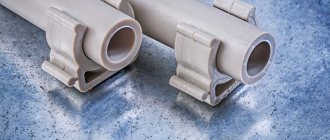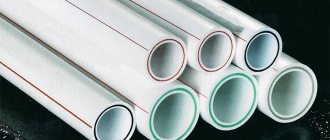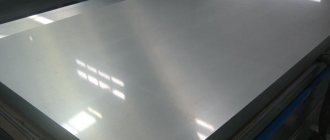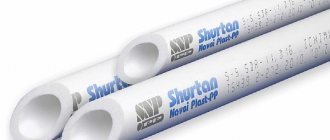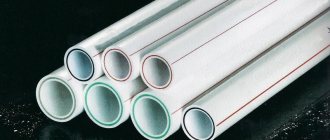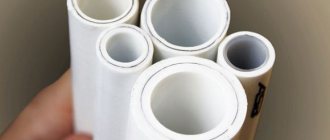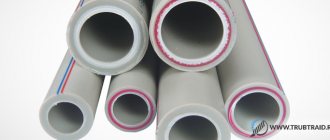How to paint a pipe?
Despite the fact that plastic pipes for heating and water supply systems have a very decent appearance and color, there are people who are interested in the question of whether they can be painted. The answer is simple - you can paint, but not all pipes, and not with any paint. Plastic pipes have a fairly smooth surface, which makes them poorly susceptible to paint - poor adhesion leads to the paint peeling off quickly. Alkaid and polyurethane paintsAcrylic with polyurethane and alkaid paints, which are sold in hardware stores, are designed specifically for coating plastic pipes. Alkaid paints are considered the safest, most environmentally friendly, repelling dirt and dust.
A prerequisite for high-quality painting is preparatory work - the pipes are degreased (as a rule, 646 solvent is used) and coated with a primer, especially for plastic. You can apply paint to pipes either with a brush or with a spray gun. Acrylic and polyurethane paints are based on an aqueous solvent. If desired, the color saturation can be made more intense or, on the contrary, paler, since the paint is initially white, and a special pigment adds color to it.
NOVALIS, PaliPlast RP Base and Astika are acrylic paint manufacturing companies that have proven themselves in the construction market. The above-mentioned manufacturers claim that polyurethane paints are environmentally friendly, dry quite quickly, and after work, a layer of paint applied to the pipes gives them additional strength. And this is true - the adhesion of the paint and the smooth surface is complete, peeling does not occur for a long period. And yet, from the entire range of plastic pipes, there are those that are so smooth that it is almost impossible to paint them; nothing can take them.
These include polypropylene and polyethylene pipes, as well as ABS and PVC plastics. To work with them, it is again necessary to use a primer, and the paint must necessarily contain organic compounds. Another condition is that such paint should not dry for more than 12 hours.
Painting pipes
If the desire to paint pipes is irresistible, then you should follow the following rules:
- the surface of the pipes must be cleaned and degreased to a state of perfect cleanliness; the surface should be treated with a primer, always acrylic; the room in which the pipes are to be painted must be heated to +18°C, and the air humidity should not exceed 80%; preferably, preparing the room before painting, ensure that everything is at the same temperature - pipes, paint, air; the thickness of the paint layer should not exceed 0.6 mm. The second coat (if necessary) can be applied only when the first one is completely dry.
By the way, if you touch the paint with your finger 8 hours after painting and it doesn’t stick, you shouldn’t delude yourself. Do not apply a second layer under any circumstances - the paint dries completely after four days.
Based on the above, it becomes clear that painting polypropylene and polyethylene pipes is a rather labor-intensive process. That is, painting ABS and PVC pipes with acrylic and water-based paint is much easier.
Repairing an apartment by the hands of specialists is an expensive pleasure.
And therefore, many owners strive to do some of the work themselves. Painting heating pipes should not cause fears that you can ruin everything. If you carefully read the instructions on how to paint heating pipes, you will be able to do everything correctly.
Paint prevents corrosion of pipes and radiators
Dye selection
Various types of coloring compounds can be used as a coating for polypropylene pipes, among which the following items stand out:
- standard paints used to protect metal surfaces;
- classic dyes intended for wall decoration;
- acrylic compositions, as well as mixtures designed specifically for plastic;
- polyurethane based dyes.
All of these types of coloring mixtures are commercially available and can be purchased at a hardware store.
Additional Information. When choosing a material suitable for painting polypropylene pipes, we advise you to contact the manager of a trade organization who will advise you on this issue.
When determining the coating application method for polypropylene, we proceed from the characteristics of the selected composition. Let's consider each of the options proposed above in more detail.
We recommend that you read: Is metal-plastic or polypropylene better for plumbing?
Reasons for painting pipes
We all know that paint, applied even in a small layer, serves as protection for water and heating pipes.
It prevents their corrosion. In addition, using paint of a certain color, you can complement the interior or simply successfully fit pipes and a radiator into it. And even if the radiator you bought already has a suitable color and a protective layer against corrosion, the same cannot be said about the pipes.
It doesn't matter what material they are made of. It is better to treat plastic and metal pipes with paint. There are a number of reasons why this measure must be carried out without fail:
- The layer of old paint has begun to peel, cracked, or has been damaged in some other way. You have just installed pipes that do not yet have protection against corrosion. The need to create completeness in the interior, decorating the heating elements. A planned measure to prevent damage to the heating system.
Preparing the surface for painting
Before you begin the painting process, you should carefully prepare the surface of the pipe. If it is an old cast iron pipe that has already begun to be damaged by corrosion, then you need to clean it with sandpaper. Then the surface is degreased and a layer of primer is applied to it. Preference should be given to primers with an anti-corrosion effect, this will ensure more reliable contact between the pipe and paint, and also prevent the progression of corrosion.
Preparing the pipeline for painting
You also need to prepare the tools and materials that may be needed during the work:
- paint for sewer pipes, selected taking into account the operational needs and technical characteristics of the pipeline;
- a bucket from which you could conveniently remove paint;
- several brushes of different sizes, preferably made of natural bristles;
- masking tape;
- primer;
- protective equipment (glasses, rubber gloves).
Note! It is much easier to work with pipes that are freely accessible. Certain difficulties may arise when painting sewer pipes in a bathroom or toilet, where communications are hidden from prying eyes.
Type
Alkyd enamel exhibits high resistance to high temperatures and can be used at temperatures up to 100 degrees Celsius. In the event of a sudden heating shutdown, you can also have peace of mind, since the coating will withstand temperature changes from -50 to + 60 degrees Celsius. Water-dispersion paint is considered the most harmless.
It dries quickly and forms a durable coating. In terms of durability, this product is also not inferior to others. When purchasing, pay attention to the fact that the can indicates the possibility of using the product for painting heated surfaces. Acrylic enamel, based on natural solvents, forms a beautiful glossy surface.
The color of the resulting layer will be durable despite exposure to ultraviolet radiation. If you do not know how to paint pipes with this paint, it is better to read the instructions first. The base must be thoroughly primed before application. For this, lead-lead primer number 81 can be used. Oil paint can be used for the above purpose, however, there is a high probability that it will turn yellow or change color due to exposure to heat.
Please also note that latex paints for metal are noticeably cheaper than acrylic paints.
How to decorate a pipe in a toilet or bathroom without painting?
Alternative methods of decoration are used in cases where paint does not adhere to pipes (for example, polyethylene or polyurethane), and the lack of space does not allow them to be sewn into a plastic or plasterboard box. Or the apartment is rented and cannot be renovated.
One way out is to cover the pipes with self-adhesive film of a suitable color. This is an inexpensive and easy to implement option. Communications can be decorated by entwining them with artificial vines made of washable material. In this case, the pipes turn into an original decoration.
By manufacturer
We can give several examples of the most common and high-quality paints for painting heating elements, which are offered to us today by manufacturers from different countries.
For heating pipes you need to use special paint
Radiator Paint is an enamel with a durable white color. It is resistant to temperatures of 90 degrees Celsius, does not emit odor or harmful substances. Millertemp is a metal paint that perfectly prevents corrosion. Available in two color options: charcoal gray or matte aluminum.
It can be applied without a primer, and after drying it can withstand temperatures up to 600 degrees Celsius. Heitzkorperlak is an alkyd enamel that forms a neat surface and can only be applied to cold metal. Elementfarg is another alkyd product that is used without a primer and dries quickly. The maximum permissible temperature is 100 degrees. It can serve as a basis for further painting or act as a finishing layer.
The paint must withstand high temperatures (preferably at least 90–100 degrees). It may contain coloring pigments or special metal powder. The last option is a higher priority.
How to choose coating paints
The coating is selected depending on how the product will be used. If the pipes are intended for hot water supply (for example, heating or bathroom), then be sure to choose a material that can protect against rust when exposed to hot water. When you see the “hot water supply” marking on the package, you can safely take it from the store shelf. Anti-corrosion paints are: pentaphthalic, organosilicon and alkyd. You can also use water-dispersed ones, but only before thoroughly priming the surface to be painted. Oil paints should not be used because they quickly change color.
- Alkyd paints. Pros: they provide good coverage, withstand high temperatures, resist mechanical stress and are wear-resistant. The color palette of this paint is varied. Cons: smells unpleasant even after drying.
- Water-dispersed. Pros: dry quickly and do not have a pronounced odor. Cons: they lose color over time and require updating.
- Acrylic. Pros: they give a glossy shine and are made from organic components; they retain their original appearance for a long time. Cons: they take a long time to dry and have a persistent and pungent odor of acetone and other solvents.
For cold water, pipes are painted with materials that can resist condensation. They should adhere well to the metal and be applied without gaps. Be sure to clean the pipes from the old coating, otherwise the new layer will peel off. Even if everything looks normal on the outside, it is quite possible that the old layers are susceptible to corrosion and have already begun to peel off.
There are many types of paints in stores. The most popular of them are PF-115, because they are inexpensive and durable. But you can also use polyurethane and epoxy materials, which are more resistant to various influences.
You can also try special enamel for rust, but it is much more expensive than regular paints, since it contains a rust inhibitor, a primer with adhesion and the enamel itself.
ogodom.ru
Color options
- over the old layer, only if it is smooth and undamaged (no cracks, chips, bulges, etc.); preliminary sanding of the surface or complete removal of the old paint: if the previous layer is damaged (cracks or swelling are visible) or you notice rust (remove it with a metal brush); if the old paint comes off, it must be completely removed and then painted.
Don't forget the primer if needed. The primer mixture is applied to a clean and dry surface, so thoroughly wipe the pipes with a damp cloth and wipe them dry with a rag.
Wait until the primer layer dries and only then start painting.
As a rule, the paint is applied very simply and does not dry for long.
Try to keep the layer minimal. If the paint is translucent, it is better to open it twice with a thin layer than once with a thick one. Although usually even manufacturers recommend applying at least two layers of coating.
After the primer has dried, apply the paint with a roller or spray gun, and you can reach hard-to-reach places with a brush (if you can’t get by with a straight brush, use a special radiator brush - it will easily fit into a thin opening and paint the part of the pipe hidden from view).
How to hide a sewer pipe?
The riser in the bathroom can be hidden in several ways. One of the most affordable options is sewing pipes into a plastic box. Experienced craftsmen recommend this type of camouflage for apartments with old communications. They argue that if one of the worn-out pipes leaks, the plastic structure will be easier to dismantle and install back after the repair.
For finishing a bathroom in a new building, the second option is more acceptable: a plasterboard box lined with tiles. This method requires more effort and money, but it is more aesthetically pleasing. The box can be equipped with a secret hatch for access to the pipes. As a rule, new risers do not require major repairs, and the likelihood that you will have to break the drywall along with the tiles glued to it is minimal.
Additional recommendations
It is better to paint heating pipes in the spring and winter, when the pipes are cold. You can paint them during the heating season, however, then you risk getting an uneven, quickly dried layer that will not be very neat.
Use only heat-resistant paints to get a durable layer that will not release harmful substances into the air when heated. If you use dark shades of paint, you will get more warmth.
Before painting, do not forget to protect the walls from accidental splashes.
Before painting, do not forget to protect the walls from accidental splashes. Cover them with old newspapers or oilcloth. Take your time so as not to create additional splashes.
When working with some products, it is better to use a respirator. Do not forget that after painting is completed, it is necessary to ventilate the room. During this process, it is better to isolate children, other family members and pets so that they do not interfere with work and do not breathe harmful fumes.
Fan (polyethylene) pipes must be painted twice a year.
Painting pipes inside and out or how to paint pipes correctly?
| Wednesday, 16 April 2014 16:45 |
Modern houses have built-in various engineering networks, including sewerage pipes, hot and cold water supply, gas pipelines and other highways. To protect against corrosion and give an aesthetic appearance, their additional processing is often relevant. In this situation, it is easiest to use paint with suitable properties if the pipe is relatively accessible.
Many will say that almost everywhere the water supply is already installed using polypropylene and metal-plastic pipes, but there are still many places where iron pipes are installed. We also must not forget that many of their summer cottages still have irrigation water pipes made of iron pipes, which also need to be renewed by painting every spring. And so, let's talk about everything in order! And we will naturally begin with the stage of preparing pipes for painting.
Cast iron pipes
Cast iron pipes and radiators are the most difficult to paint.
These elements are usually painted directly over the old layer. However, this only worsens their appearance, because the surface becomes more and more uneven each time. It’s better to spare no time and effort and remove the old layer of paint.
After this, be sure to expose the metal with a primer. If it is not easy to reach hard-to-reach places, then first remove the radiator and those parts of the pipe that can be removed. Paint everything, and after drying, install it back.
For cast iron elements, it is best to use soft foam rollers of small diameter for uniform painting.
How to paint plastic pipes
Plastic pipes have certain features compared to cast iron products. They have a very smooth surface. On the one hand, this is an advantage, since the smooth surface does not allow sediment to accumulate inside the pipe. Some types of pipes cannot be painted at all. Polyethylene and polypropylene pipes can be painted, however, the paints crack and darken.
So, how to paint a plastic sewer pipe? The coloring agent must be selected taking into account the following requirements:
- organic composition;
- the paint must dry in less than 12 hours (drying time is indicated on the label);
- layer hardness and color density.
Note! Plastic sewer pipes should be painted in rooms where the temperature fluctuates within +18 degrees.
Useful tips
You should work in gloves and work clothes, and when spraying aerosol materials, wear a mask and goggles. All tools must be promptly cleaned of paint before it dries. The floor under the pipe and other nearby surfaces must be covered with film in advance, then they will not have to be cleaned from accidentally falling drops of paint.
Many compounds have a strong odor or contain toxic volatile components, so you need to ensure a constant flow of fresh air into the work area. This can be done by opening the door and placing a fan on inside the washroom.
I hope you have received the necessary recommendations to decorate your sewer pipes. The following video offers another way to design communications.
This entry was posted on Saturday, March 7th, 2021 at 12:05 am and is filed under Category name. You can follow any responses to this entry through the RSS 2.0 feed. You can leave a response, or trackback from your own site.
Related publications:
- Do I need to paint polypropylene pipes?
- Copper pipe painting
- How to paint a gas pipe
- What are plastic pipes used for?
- Important parameters of plastic pipes
- Insulation of heating pipes
“in one layer approximately 5-6 mm thick” What, excuse me?! A layer of paint of 5-6 mm?!
To give plastic pipe products the desired color during their manufacture, various dyes are added to the source material. There may be cases when the user, even before repairs, purchases blanks of the usual type, and he needs to paint them in a color suitable for the room.
There is only one way to solve this issue - paint polypropylene pipes with a composition suitable for the design of the room.
Features of application
Dyes for metal
Advantages of using regular metal paint:
- the availability of this dye, widely used in everyday life;
- reasonable cost;
- ease of preparation for application, which does not require pre-treatment of the surface of polypropylene pipes with special protective agents.
When working with this product, no material preparation is required; You just need to apply paint on it and wait for it to dry.
Note! For this purpose, a spraying method is used, implemented using a special spray gun.
But this method also has disadvantages, which are manifested in the sharp and unpleasant smell of the dyes, as well as the fact that they have a very thick consistency. Therefore, you should work with them as quickly as possible or use a solvent specially designed for diluting these paints.
Regular dyes to match the color of the walls
This approach has even more disadvantages and they are expressed in the instability of the coloring compositions used in heating systems. Wall paint is not designed to withstand high heat, so the coating will lose its original appearance over time.
Its deterioration usually manifests itself in peeling of the top layer of dye and its gradual falling off in the form of characteristic scales.
But this option also has its advantages, expressed in the invisibility of pipelines against the background of walls, the versatility of the compositions used, as well as an expanded range of colors.
Painting with compositions based on acrylic and polyurethane
Dyes of this class are among the “softest” of all household mixtures used for painting pipes. The solvent they contain does not pose a danger to plastic, which has a wide range of colors. In addition, such compositions are easily applied to pipe surfaces and do not have a pungent odor.
The disadvantage of such materials is the threat of cracking under strong heating, which is possible when they are used for painting workpieces of limited thickness used in heating systems.
Let's add to this that before applying acrylic to the surface, the latter must first be thoroughly primed.
Polyurethane paints are used extremely rarely for these purposes, which is explained by the need for preliminary priming, as well as the limited temperature range.
Use of special dyes
The only drawback of special compositions for painting polypropylene is their high cost. Despite this, many users note that they do not last any longer than the materials already discussed.
In this case, you don’t have to worry about the safety of polypropylene.
The solvent contained in these dyes is completely safe for pipe products, and their resistance to high temperatures allows them to be used in heating lines.
After painting with these mixtures, the pipes must be left to dry for some time. The drying speed of paint depends on the current time of year and increases significantly on hot and dry summer days.
Painting pipes with priming
This option for painting polypropylene is fundamentally different in its approach to surface preparation. It involves the use of a special primer, which is available in the form of an aerosol.
The primer composition reliably protects the surfaces being treated and ensures good adhesion to the paint used.
Additional Information. This protective agent is used when painting car bodies, so you can find it in car repair shops.
In conclusion, we note that in order to give the elements of water supply and heating systems the desired color shade, it is necessary to be able to choose the right type of dye and method of its application. This can be achieved after studying the recommendations discussed in our review.
Before you decide to paint anything, you need to choose the right coloring material. Since the range of paints today is quite wide, we decided to talk about how you can paint PVC plastic with your own hands: what paints and varnishes are suitable for this raw material, as well as what technologies exist for applying them to plastic.
